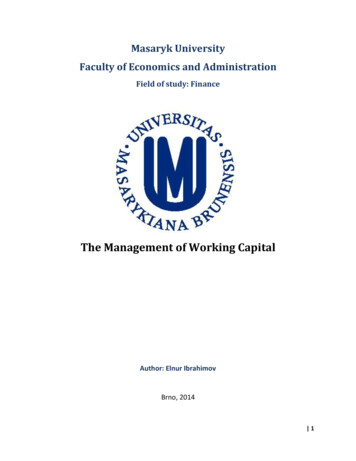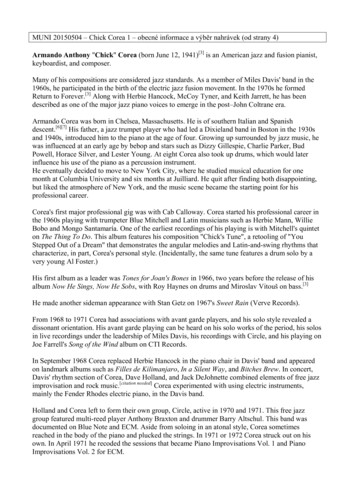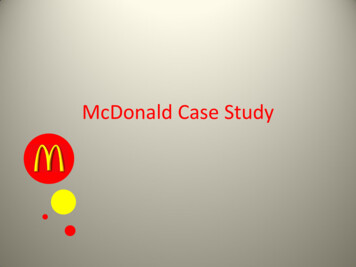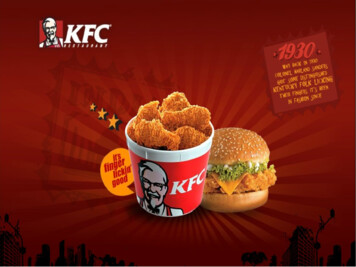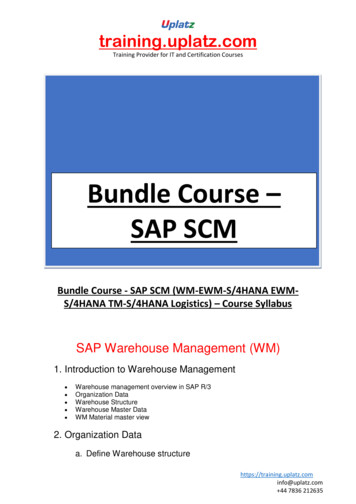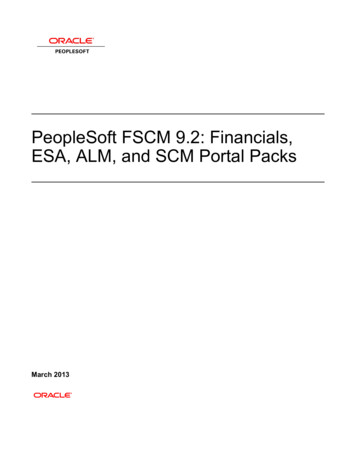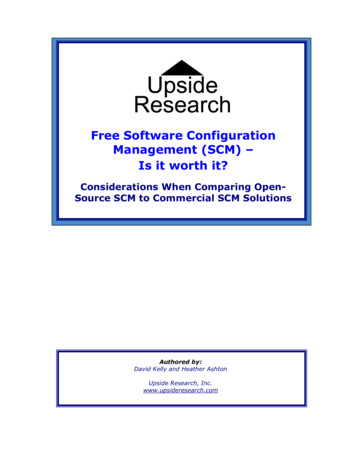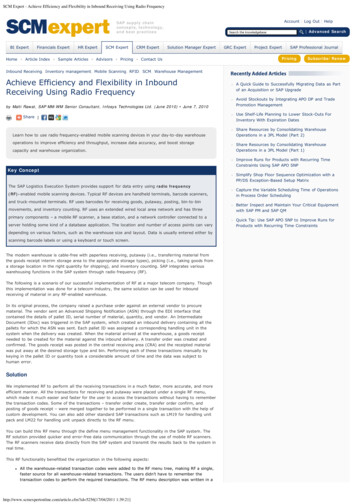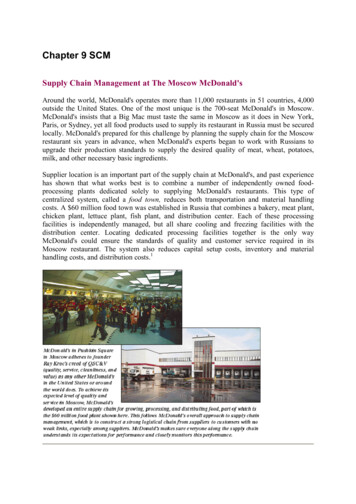
Transcription
Chapter 9 SCMSupply Chain Management at The Moscow McDonald'sAround the world, McDonald's operates more than 11,000 restaurants in 51 countries, 4,000outside the United States. One of the most unique is the 700-seat McDonald's in Moscow.McDonald's insists that a Big Mac must taste the same in Moscow as it does in New York,Paris, or Sydney, yet all food products used to supply its restaurant in Russia must be securedlocally. McDonald's prepared for this challenge by planning the supply chain for the Moscowrestaurant six years in advance, when McDonald's experts began to work with Russians toupgrade their production standards to supply the desired quality of meat, wheat, potatoes,milk, and other necessary basic ingredients.Supplier location is an important part of the supply chain at McDonald's, and past experiencehas shown that what works best is to combine a number of independently owned foodprocessing plants dedicated solely to supplying McDonald's restaurants. This type ofcentralized system, called a food town, reduces both transportation and material handlingcosts. A 60 million food town was established in Russia that combines a bakery, meat plant,chicken plant, lettuce plant, fish plant, and distribution center. Each of these processingfacilities is independently managed, but all share cooling and freezing facilities with thedistribution center. Locating dedicated processing facilities together is the only wayMcDonald's could ensure the standards of quality and customer service required in itsMoscow restaurant. The system also reduces capital setup costs, inventory and materialhandling costs, and distribution costs.1
1P. Ritchie, "McDonald's: A Winner Through Logistics," International Journal of Physical Distribution andLogistics Management 20, no. 3 (1990): 21-24.A supply chain is made up of the interrelated organizations, resources, and processes thatcreate and deliver products and services to end customers. A supply chain encompasses all thefacilities, functions, and activities involved in producing and delivering a product or service,from suppliers (and their suppliers) to customers (and their customers). It includes planningand managing supply and demand; acquiring materials; producing and scheduling the productor service; warehousing, inventory control, and distribution; and delivery and customerservice. Supply chain management coordinates all these activities so that customers can beprovided with prompt and reliable service of high-quality products at the least cost.Successful supply chain management in turn can provide the company with a competitiveadvantage.Facilities along the supply chain include plants, warehouses, distribution centers, servicecenters, and retail operations. Products and services can be distributed by rail, truck, water,air, pipeline, computer, mail, telephone, or in person. Processes within the supply chaininclude forecasting of product or service demand, selecting suppliers (sourcing) and orderingmaterials (procurement), inventory control, scheduling production, shipping and delivery,information management, quality management, and customer service. Most of the topics inthis text fall somewhere within the supply chain. Managing the supply chain is tantamount tocoordinating all the operations of a company with the operations of its suppliers andcustomers.The delivery of a product or service to a customer is a complex process encompassing manydifferent interrelated facilities, processes, and activities. First, demand for a product or serviceis forecast, and plans and schedules are made to meet demand within a time frame. Theproduct or service can require multiple suppliers (who have their own suppliers) who prepareand then ship parts and materials to manufacturing or service sites. One of the largestproducers, General Motors, has more than 2,500 suppliers that serve its 120 parts plants and30 auto and truck assembly plants. Parts and materials are transformed through complexprocesses into final products or services. Finally, these products are shipped to external orinternal customers. However, this may not be the final step at all as these customers maytransform the product or service further and ship it on to their customers. All of this is part ofthe supply chain; that is, the flow of goods and services from the materials stage to the enduser.What makes this process so complicated, and the management of the supply chain socomplex, is the uncertainty all along the supply chain at every stage. Uncertainty in the formof wrong forecasts, late deliveries, poor-quality materials or parts, machine breakdowns in themanufacturing process, canceled orders, erroneous information, slow information,transportation breakdowns, and the like cause "breaks" in the supply chain that can result inpoor customer service; that is, not having the product or service available to customers whenand where they want it. Companies cope with this uncertainty with their own form of"insurance," inventory. All companies carry inventory to minimize the negative effects ofuncertainty and to keep the productive process flowing smoothly from suppliers to thecustomer. However, inventory is very costly so companies--both suppliers and theircustomers--would like to minimize it. Thus, one important objective of supply chainmanagement is to coordinate all the different activities, or "links" of the chain, so that goodscan move smoothly and on time from suppliers to customers to distribution to suppliers tocustomers, while keeping inventories low and costs down.
Unfortunately, the different companies that depend on each other to produce a product orservice do not always work together and that is a dilemma of supply chain management.Customers do not want to have to keep large, costly inventories so they demand that theirsuppliers keep them instead so their service will not suffer, and these suppliers pressure theirsuppliers to do the same, and so on, all the way down the supply chain.Effective supply chain management requires that suppliers and customers work together in acoordinated manner by sharing and communicating information by talking to one another. Itis the rapid flow of information among customers, suppliers, distribution centers, andtransportation systems that has enabled some companies to develop very efficient supplychains. Suppliers and customers must also have the same goals; that is, that they be on thesame page. Suppliers and customers need to be able to trust each other: Customers need to beable to count on the quality and timeliness of the products and services of their suppliers.Further, suppliers and customers must participate together in the design of the supply chain toachieve their shared goals and to facilitate communication and the flow of information.Some companies attempt to gain control of their supply chains by vertically integrating--byowning and controlling all the different components along the supply chain from materialsand parts procurement to delivery of the final product and customer service--like theMcDonald's in Moscow described at the beginning of this chapter. However, even with thistype of organizational structure, the different functions and operating units can beuncoordinated. For example, at a computer manufacturer one facility producing chipsresponded to demand pressure from another company facility producing motherboards byincreasing capacity at considerable cost, only to learn later that the chips were never a sourceof delay in the delivery of motherboards further down the supply chain. At Nabiscopurchasing figured that they would save more than a half-million dollars by reducing thetensile strength of a box, but as a result of the weakened boxes they suffered more than amillion dollars in product returns further downstream in the supply chain.No matter what type of organizational structure exists within a company, it still must focus oncoordinating its different activities to achieve overall company goals.As this brief discussion illustrates, supply chain management encompasses so many differentinterrelated topics that it is not possible to cover all of them in a single chapter. Thus, we mustdevote separate chapters to some of them including forecasting, production and scheduling,inventory control, and quality. In this chapter we will focus on several key elements of thesupply chain including the supplier-customer relationship and purchasing (also known assourcing and procurement), type and location of facilities, transportation, and distribution.Supply Chain Design: A Strategic IssueSince a company's supply chain encompasses virtually all of its operating functions andfacilities, its design is necessarily an integral part of its strategic planning process. For mostcompanies the goals of their strategic plan are often the same as the objective of supply chainmanagement--the prompt and reliable delivery of high-quality products and services at the
least cost. To accomplish this requires strategic design decisions that effectively coordinate allof the supply chain functions. It is not surprising that many of the same strategic designconsiderations for a quality management program can be applied to supply chain design.The central component of the strategic planning process is a goal or set of goals. In supplychain management before goals can be established, it is necessary to know what currentperformance is and what is possible after improvement or reengineering. In total qualitymanagement (TQM), this is referred to as benchmarking, measuring where the company(and/or a competitor) is now and using that as a guideline as to where the company wants tobe in the future. However, a company must measure performance and set goals in terms of thesupply chain as a whole, not just itself. A company may set high goals for itself forminimizing inventory, but if the inventory levels of its suppliers are required to be excessivelyhigh just so the company can achieve its own local goals without regard to the suppliers'costs, then the cost of the high inventory will eventually be passed on to the company ashigher delivery, material and, parts costs anyway. If a company achieves its own quality goalsand ignores the quality programs of its suppliers, then its quality will be adversely affected.Thus, the supply chain must be designed to minimize inventory and achieve high qualityamong both suppliers and customers.This level of interdependence and goal sharing makes the selection of suppliers, also calledsourcing, and the purchasing process, also called procurement, important strategic decisionsfor a company. Suppliers must be reliable in terms of quantity, timeliness, and quality.McDonald's expects delivery of its food ingredients from suppliers within two days of placingan order--always. Changing suppliers frequently can lead to interruption and delays in theflow of materials to the production process; too many suppliers can be difficult to coordinateand control; and too many suppliers can be risky, if they are not reliable, and can cut down oncompetition and the incentive to keep prices low. Suppliers must be perceived as a virtualextension of the customer, operating with the same goals and quality expectations.For a company to achieve its strategic goals, it must control the bane of supply chainmanagement we mentioned earlier--uncertainty. This requires identifying and understandingthe causes of the uncertainty, determining how it affects other activities up and down thesupply chain, and then formulating ways to reduce or eliminate it. An effective means foridentifying and reducing uncertainty is to strategically apply the principles of TQM, includingstatistical process control, all along the supply chain. This means that suppliers use TQM toensure quality products are delivered on time to customers; distribution centers employ TQMto make sure that products are packaged, handled, and shipped on time with no damage orprocessing errors; and shippers deliver products undamaged to the right place on time.Another important aspect of supply chain design is communication and information flow.Advances in computer technology and the Internet have made it possible for suppliers,customers, distribution centers, and shippers to communicate almost instantaneously, thusenhancing the ability to coordinate these different supply chain processes. Computerizedpoint-of-sale information can be transmitted instantaneously via communication networks todistribution centers and shippers enabling quick delivery to customers and quickreplenishment of warehouse stocks by suppliers. If everyone along the supply chain hasaccess to the same information at the same time, it enables them all to coordinate closely andthus reduce uncertainty, which in turn allows them to reduce inventory levels.
The types and number of facilities to construct (or acquire) and where to locate them arestrategic design issues since transportation and distribution costs can be a significant part ofsupply chain costs. Facility and location decisions are costly, long-term commitments. Theyalso dictate other design decisions including which suppliers to use, modes of transportation,distribution centers, and customer markets. For example, 75 percent of Honda's suppliers arewithin 150 miles of its Marysville, Ohio, plant, and it uses locally based trucking companiesto ship its parts and materials.Wal-Mart is an example of a company that has incorporated these various designcharacteristics into an effective and successful supply chain. Wal-Mart's competitive strategyis to provide quality goods to its customers when and where they want them at a competitiveprice. The key to achieving these strategic goals has been a feature of its supply chain designknown as "cross-docking." In its cross-docking system, products are delivered to Wal-Mart'swarehouses on a continual basis where they are sorted, repackaged, and distributed to storeswithout sitting in inve
Supply Chain Management at The Moscow McDonald's Around the world, McDonald's operates more than 11,000 restaurants in 51 countries, 4,000 outside the United States. One of the most unique is the 700-seat McDonald's in Moscow. McDonald's insists that a Big Mac must taste the same in Moscow as it does in New York, Paris, or Sydney, yet all food products used to supply its restaurant in Russia .
